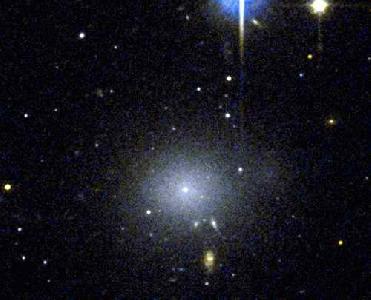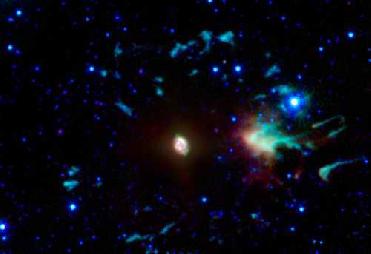
This object, [CGW2003] J031931.7+4131, is one of four dwarf galaxies that is part of a census of small galaxies in the tumultuous heart of the nearby Perseus galaxy cluster. NASA image
LONDON (BNS): Looking into the Perseus galaxy cluster, NASA’s Hubble Space Telescope uncovers galaxies embedded in halos of dark matter. In a research published in the March 1 issue of the Monthly Notices of the Royal Astronomical Society, astronomers state that the Hubble has discovered a large population of small galaxies that have remained intact while larger galaxies around them are being ripped apart by the gravitational tug of other galaxies.
Dark matter is an invisible form of matter that accounts for most of the universe’s mass. Astronomers have construed the existence of dark matter by observing its gravitational influence on normal matter, consisting of stars, gas, and dust. The Hubble images provide further evidence that a ‘cushion’ of dark matter, which protects them from their rough-and-tumble neighbourhood, enshrouds the undisturbed galaxies.
Astronomer Christopher Conselice of the University of Nottingham, UK, and leader of the Hubble observations, said that they were surprised to find so many dwarf galaxies in the core of this cluster that were so smooth and round and had no evidence at all of any kind of disturbance. “These dwarfs are very old galaxies that have been in the cluster a long time. So if something was going to disrupt them, it would have happened by now. They must be very, very dark-matter-dominated galaxies,” Conselice said.
The astronomer said that dwarf galaxies might have an even higher amount of dark matter than spiral galaxies. “With these results, we cannot say whether the dark-matter content of the dwarfs is higher than in the Milky Way Galaxy. Although, the fact that spiral galaxies are destroyed in clusters, while the dwarfs are not, suggests that is indeed the case,” Conselice said.
The Perseus Cluster is too far away for telescopes to resolve individual stars and measure their motions. So Conselice and his team derived a new technique for uncovering dark matter in these dwarf galaxies by determining the minimum mass the dwarfs must have to protect them from being disrupted by the strong, tidal pull of gravity from larger galaxies.
Studying these small galaxies in detail was possible only because of the sharpness of Hubble’s Advanced Camera for Surveys. Conselice and his team first spied the galaxies with the WIYN Telescope at Kitt Peak National Observatory outside Tucson, Arizona.
Those observations, Conselice says, only hinted that many of the galaxies were smooth and therefore dark-matter dominated. “Those ground-based observations could not resolve the galaxies, so we needed Hubble imaging to nail it,” he said.
 Previous Article
Previous Article














The Indian Air Force, in its flight trials evaluation report submitted before the Defence Ministry l..
view articleAn insight into the Medium Multi-Role Combat Aircraft competition...
view articleSky enthusiasts can now spot the International Space Station (ISS) commanded by Indian-American astr..
view article